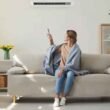For many homeowners, indoor air quality plays a crucial role in managing allergy symptoms year-round. While outdoor allergens like pollen and dust are unavoidable, the air inside a home can be controlled with the right approach to heating, ventilation, and air conditioning. A properly maintained HVAC system filters, circulates, and purifies indoor air, keeping harmful particles from spreading. When these systems are optimized for allergy relief, they help reduce sneezing, coughing, and irritation by trapping allergens before they reach living spaces. The goal is not only comfort but also long-term respiratory health. By adjusting maintenance routines, improving filtration, and enhancing airflow, your HVAC system can become a powerful tool in creating a cleaner, more breathable home environment.
Improving Air Filtration for Cleaner Indoor Air
One of the most effective ways to use your HVAC system for allergy relief is through better filtration. Air filters act as the first line of defense, capturing dust, pollen, pet dander, and other airborne irritants before they circulate through the home. Basic filters are designed mainly to protect the system, but upgrading to higher-efficiency filters can make a significant difference for allergy sufferers. High-efficiency particulate air (HEPA) filters, for instance, trap even the tiniest particles, creating noticeably cleaner air. However, using advanced filters requires ensuring your system can handle the increased air resistance. Regular filter changes are also critical—dirty filters restrict airflow, reduce efficiency, and allow allergens to recirculate. A clean, appropriately rated filter ensures your system runs smoothly while keeping allergens under control. Homeowners who take filtration seriously often notice improved air quality and fewer allergy symptoms within weeks of consistent maintenance.
Balancing Humidity for Allergy Prevention
Humidity control is another vital factor in reducing allergic reactions. Both excessive moisture and overly dry air can worsen symptoms. High humidity encourages mold growth and dust mites, while dry air irritates nasal passages and throats. A properly calibrated HVAC system maintains ideal humidity levels—typically between 40% and 50%—to keep air comfortable and allergen levels low. Installing a whole-home humidifier or dehumidifier ensures balance year-round, regardless of outdoor weather conditions. Regularly checking humidity readings helps prevent sudden spikes that create unhealthy environments. Technicians from E.J. Thompson & Son LLC of Charleston often recommend pairing humidity control devices with smart thermostats to maintain consistent humidity levels automatically. Proper humidity regulation also helps preserve furniture, flooring, and other home materials that are sensitive to moisture fluctuations. The right balance keeps air fresh, reduces microbial growth, and provides a noticeable improvement in respiratory comfort for allergy-prone individuals.
Cleaning Ductwork to Eliminate Hidden Allergens
Ducts are responsible for distributing air throughout the home, but over time, they can accumulate dust, pet hair, and even mold spores. When air passes through these contaminated ducts, allergens spread easily, worsening symptoms for sensitive individuals. Cleaning ductwork helps remove buildup that ordinary filters can’t reach, restoring clean airflow and improving efficiency. It also prevents dust from resettling on furniture and surfaces after every cycle. Homeowners should schedule professional duct inspections every few years, especially if they notice uneven airflow or persistent dust accumulation. Sealing duct gaps or leaks ensures conditioned air flows directly to living areas rather than escaping into attics or crawl spaces. Cleaner ducts also reduce energy consumption, as the HVAC system doesn’t have to work as hard to push air through obstructed pathways. This process significantly contributes to allergy prevention while extending the life of your entire HVAC system.
Using Air Purifiers for Targeted Allergen Control
While air filters and ducts handle much of the work, stand-alone or integrated air purifiers can offer an extra layer of defense. These devices use advanced filtration methods—such as activated carbon filters or ultraviolet (UV) light—to eliminate allergens, bacteria, and odors from circulating air. When connected to the HVAC system, purifiers treat air as it moves through ducts, neutralizing harmful particles before they reach rooms. Portable purifiers, on the other hand, can target specific problem areas, such as bedrooms or living spaces, where allergy triggers are most noticeable. UV light purifiers are particularly effective against mold spores and microorganisms, breaking them down at the molecular level. Combining purification technology with regular filter changes ensures a comprehensive air-cleaning strategy. For those with severe allergies or asthma, these enhancements create a noticeable difference in air clarity, making indoor environments more comfortable and less reactive.
Maintaining Airflow and Ventilation Efficiency
Good airflow is key to keeping allergens from accumulating in stagnant air pockets. Blocked vents, dirty fans, and obstructed ducts prevent proper air circulation, allowing irritants to linger longer indoors. Regularly checking and cleaning vents ensures unrestricted flow throughout the home. Additionally, keeping interior doors open while the HVAC system is running helps maintain even air distribution. Proper ventilation is equally essential—fresh outdoor air needs to mix with conditioned air to dilute allergens and pollutants. Many modern systems feature energy recovery ventilators (ERVs) that introduce filtered outdoor air without sacrificing efficiency. Maintaining steady airflow reduces temperature fluctuations and ensures the system operates effectively at all times. When air moves freely and filters remain clean, the entire home feels fresher, with fewer particles settling on surfaces. Consistent ventilation and balanced air pressure contribute directly to healthier indoor environments and more effective allergy management.
Scheduling Regular HVAC Maintenance for Long-Term Results
Consistent maintenance ensures that every component of your HVAC system continues to perform efficiently. Seasonal tune-ups allow technicians to identify early signs of wear, clean essential parts, and recalibrate controls for optimal performance. During maintenance visits, key components such as coils, fans, and condensate drains are inspected for dirt or blockages that could affect air quality. Keeping these elements clean prevents allergens from being reintroduced into the air supply. Maintenance also helps prevent humidity imbalances and inefficient airflow, both of which can worsen allergy symptoms. By scheduling inspections twice a year—before cooling and heating seasons—homeowners maintain a system that consistently delivers clean, balanced air. Proactive care also reduces the need for costly repairs while extending the unit’s overall lifespan. With regular maintenance, HVAC systems not only improve air quality but also maintain peak energy efficiency, ensuring steady allergy relief throughout the year.
Combining Smart Technology with Air Quality Control
Advancements in smart home technology have made managing air quality easier than ever. Smart thermostats, air quality monitors, and connected HVAC controls allow homeowners to track allergen levels and make real-time adjustments. Sensors detect dust, humidity, and temperature changes, automatically optimizing settings to maintain a healthy indoor environment. Notifications sent directly to smartphones can remind users when filters need to be changed or maintenance is due. Some systems even integrate with air purifiers and humidifiers, creating a fully automated network for allergy management. This connectivity ensures consistent comfort and cleaner air without constant manual oversight. Intelligent systems also provide detailed reports on energy use and indoor conditions, helping homeowners make informed decisions about their environments. As technology continues to advance, these tools play an increasingly important role in creating homes that are both energy-efficient and allergy-friendly, reducing effort while improving long-term respiratory health.
Creating a Healthier Home Through Optimization
Optimizing your HVAC system for allergy relief is a long-term investment in both comfort and health. By improving filtration, cleaning ducts, balancing humidity, and incorporating purification technologies, you can dramatically reduce allergens that cause discomfort. Regular maintenance and intelligent automation ensure the system continues to function effectively without excessive effort. The result is a cleaner, more consistent indoor environment where air quality supports well-being rather than aggravating allergies. Every adjustment contributes to a healthier home that feels fresher year-round. With careful attention and proactive management, your HVAC system becomes more than a climate control tool—it becomes a shield against allergens, providing lasting comfort and peace of mind.









